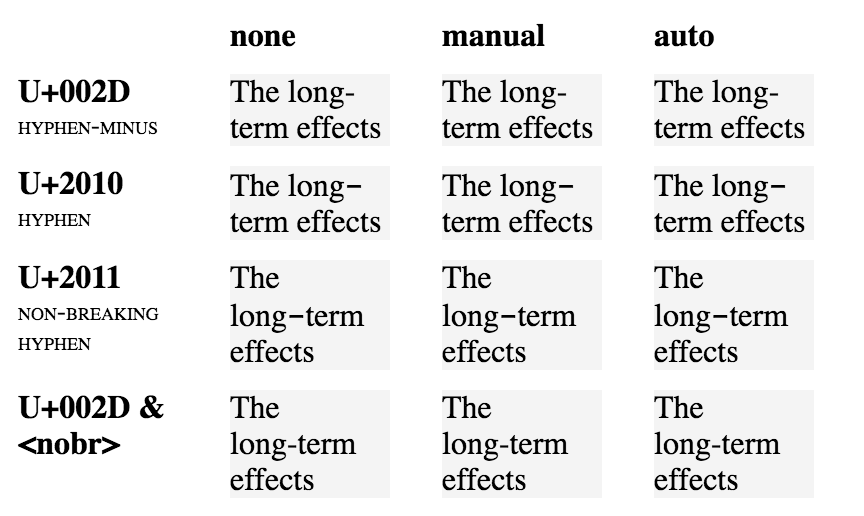Description
I want to prevent hyphenation/line breaking of words containing hyphens (hyphenated compounds). Some common examples of hyphenated compounds in English are , , and .
Why?
This behavior is important for documents that prioritize legibility over aesthetics, such as:
- highly technical documents¹
- documents that will primarily be read out loud
- pedagogical documents
These documents may want to apply the behavior to the entire document, not on a case-by-case basis.
¹ This very spec once faced a similar issue in which unwanted hyphenation led to confusion: #2307
Current status
CSS Text Module Level 3 does not define what hyphenation opportunities are:
Hyphenation occurs when the line breaks at a valid hyphenation opportunity…. CSS Text Level 3 does not define the exact rules for hyphenation….
Under hyphens, it says:
- none
- Words are not hyphenated, even if characters inside the word explicitly define hyphenation opportunities.
However, hyphens: none does not give the expected result in most browsers.
For example, see how Chrome 70/Mac renders this JSFiddle:
I am concerned that the current spec gives authors very little control over a simple display requirement. For example, it never mentions the behavior of U+002D HYPHEN-MINUS, the most widespread hyphen character by far, even once.
Some workarounds
Wrap all hyphenated compounds in <span style="white-space:nowrap;"> or <nobr> (nonstandard).
Cons:
- Adds lots of unnecessary, presentational markup
Surround all hyphens with U+2060 WORD JOINER.
Cons:
- Affects searching and copying
Replace all hyphens with U+2011 NON-BREAKING HYPHEN.
Cons:
- Affects searching and copying
- Affects display; may look very ugly depending on the font (or fallback font)
- Few fonts have a glyph for U+2011 (379 out of 3426 on my system do).
Even if they do, U+2011 may not look identical to U+002D or U+2010.
- Few fonts have a glyph for U+2011 (379 out of 3426 on my system do).
The Unicode Line Breaking Algorithm (UAX 14) recommends this method, but it seems rare in practice:
- 2011 NON-BREAKING HYPHEN
- This is the preferred character to use where words need to be hyphenated but may not be broken at the hyphen. Because of its use as a substitute for ordinary hyphen, the appearance of this character should match that of U+2010 HYPHEN.
Possible solutions
- Define “hyphenation opportunities”
- Re(de)fine
hyphens: none - Add a brand new value, such as
hyphens: none-including-hyphens
Questions
- Does this affect CSS Text Module Level 3 or Level 4, or neither?
- Will it impact the Last Call?
I can’t find any previous discussion on this topic; sorry if it’s a duplicate.
Thank you for considering this feedback – it’s my first time engaging with the standards process.
Further reading
- StackOverflow: No line-break after a hyphen (▲293, 2011)
- StackOverflow: How to prevent line break at hyphens on all browsers (▲80, 2012)
- StackOverflow: Is it possible to prevent linebreaks between hyphenated words in CSS? (▲1, 2018)
- Welling Guzmán: Prevent line-break with hyphenated words (2015)
- CSS-Tricks: Handling Long Words and URLs (Forcing Breaks, Hyphenation, Ellipsis, etc) (2018)
Unfortunately,
hyphen: nonewill still break words at hyphens (an explicitly defined hyphenation opportunity) even though the spec says it shouldn’t. - [css-text-4] Hyphenate only overflowing words? #616, [css-text-3] hyphenation priority #618, [css-text] automatic hyphens should repect all kinds of manual hyphens #1040
- CSSWG: Minutes Telecon 2016-11-02: Hyphenation Priority (2016)
- Jukka Korpela: Word division in IE and other notes on the nobr markup and on suggesting possible "word" breaks (2000)
- dotCSS 2018: Florian Rivoal: Line breaking (2018)
- Google Docs Help Forum: Insert non-breaking space/hyphen (2010)
Note that Google Docs renders hyphens as non-breaking by default in its browser view. - Eric Meyer: Where to Avoid CSS Hyphenation (2012)
Metadata
Metadata
Assignees
Labels
Type
Projects
Status
